Numerical Study of the Out-of-Plane Response of Dry-Stack Double-Wythe Brick Walls with Header Bricks
Abstract
1. Introduction
1.1. Background on Unreinforced Masonry (URM) Behavior
1.2. Previous Studies on In-Plane and Out-of-Plane Behavior
1.3. Knowledge Gap on Dry Double-Wythe Masonry
1.4. Objectives and Novel Contributions
2. Numeric Investigation
2.1. Specimen Preparation
2.2. Finite Element Modeling Approach
2.3. Analysis Setup, Load Procedure, and Boundary Conditions
2.4. Mesh Configuration and Solver Settings
2.5. Material Model and Contact Definition
| Brick Material | |||
| Definitions | Value | Notes | References |
| Density (γ), kN/m3 | 15.267 | [26,27,83] | |
| Compressive strength (fb), MPa | 23 | [26,27,83] | |
| Tension stress (fct), MPa | 0.218 | [27] | |
| Elastic modulus of brick (Eu), MPa | 16,700 | [57,80,84] | |
| Poisson’s ratio (νu) | 0.15 | ||
| Contact details | |||
| Tangential behavior Friction coefficient | 0.82 | Determined under different vertical loads | [26,27,83] |
| Normal behavior | Hard contact | To avoid penetration of nodes | |
| Allow separation after contact | This condition was allowed to enable separation after contact. | ||
| Cohesive behavior | This was omitted due to the absence of mortar | ||
| Contact control | PSSF = 1 × 10−3 obtained from sensitivity analysis | ||
2.6. Validation of Analysis
3. Results and Discussion
3.1. Effect of the Number and Arrangement of Header Bricks on OOP Failure
3.2. The Effect of Header Bricks on OOP Failure and the Parametric Approach Framework
3.3. Discussion of Existing Applications
4. Conclusions
- The double-wythe wall without header bricks had the lowest V/W ratio due to the lack of interlocking between the wythes. In this wall, the inner and outer wythes moved separately, and the wall collapsed with low lateral capacity. In addition, the stiffness decreased, and the influence of local defects on the performance of the wall in the brick became more apparent.
- As the vertical rows of header bricks increased, enhanced out-of-plane behavior was attained, and higher V/W ratios were reached. This situation reveals that the capacity of the structure is directly related not only to the number of existing header bricks but also to their regular arrangement.
- The most resistant wall structure was achieved by interlocking the inner and outer wythes of the wall with four vertical rows of header bricks. The V/W ratio of this wall increased by a factor of up to 1.81 compared to the one without header bricks. A similar arching displacement pattern was observed at the inner and outer wythes.
- The O-pattern header brick arrangement in the front wall increased the V/W ratio by a factor of 1.61. In a similar arrangement, the use of three vertical rows and more header bricks increased the V/W ratio by a factor of 1.68. Accordingly, the O-pattern exhibited a 4.2% lower performance. The findings suggested that even though the header bricks were distributed over the entire wall, their contributions scaled directly with the number of bricks.
- On the front wall, the lateral load capacity of the A-pattern was found to be 14% higher than that of the V-pattern. The header bricks contributed to transferring the loads more uniformly to the wall foundation. The failure mechanisms of the two wall models were different.
- A close agreement was observed between the numerical results and the referenced experimental results.
- The use of header bricks not only increased the load capacity but also increased the stiffness and reduced the deformation. The header bricks provided a significant advantage for the walls in terms of strength and stability, especially under seismic activity.
Funding
Institutional Review Board Statement
Informed Consent Statement
Data Availability Statement
Conflicts of Interest
References
- Dazio, A. The Effect of the Boundary Conditions on the Out-of-Plane Behaviour of Unreinforced Masonry Walls. In Proceedings of the the 14th World Conference on Earthquake Engineering, Beijing, China, 12 October 2008. [Google Scholar]
- Kıpçak, F.; Erdil, B. Yığma Yapıların Düzlem Dışı Davranışlarına Yan Duvarın ve Yan Duvar Boşluğunun Etkisi. Niğde Ömer Halisdemir Üniversitesi Mühendislik Bilim. Derg. 2023, 12, 853–860. [Google Scholar] [CrossRef]
- Atailia, S.; Meftah, S.A.; Fouchal, F.; Laib, S. eddine Dynamic Homogenization Approach for In-Plane and out-of-Plane Linear Vibration Analysis of Masonry Wall Structures. Struct. Des. Tall Spec. Build. 2020, 29, e1802. [Google Scholar] [CrossRef]
- Anas, S.; Alam, M.; Umair, M. Behavior and Damage Assessment of Monolithic and Non-Monolithic Braced Masonry Walls Subjected to Blast Loadings Using a Detailed Micro-Modeling. Int. J. Mason. Res. Innov. 2022, 434, 02034. [Google Scholar]
- Shi, Y.; D’Ayala, D.; Prateek, J. Analysis of Out-of-Plane Damage Behaviour of Unreinforced Masonry Walls. In Proceedings of the 14th International Brick & Block Masonry Conference, Sydney, Australia, 13–20 February 2008; pp. 2–17. [Google Scholar]
- Budak, A.; Uysal, H.; Aydin, A.C. Kırsal Yapıların Deprem Karşısındaki Davranışı. Atatürk Üniversitesi Ziraat Fakültesi Derg. 2004, 35, 3–4. [Google Scholar]
- Gençer, F.; Hamamcıoğlu Turan, M.; Vardaroğlu, M.; Aktaş, E. Evaluation of Structural Strength of Two Hellenistic Towers in Alinda, Latmos and Caria. In Proceedings of the Uluslararası Katılımlı 6. Tarihi Yapıların Korunması ve Güçlendirilmesi Sempozyumu, Ortahisar, Türkiye, 2–4 November 2017. [Google Scholar]
- Kıpçak, F. Tilting Table Experiments to Determine the Out-of-Plane Behavior of Masonry Structures Which Side Wall Hollow Is Constructed from Brick. Master’s Thesis, Van Yüzüncü Yıl Üniversitesi Fen Bilimleri Enstitüsü, Van, Türkiye, 2018. [Google Scholar]
- Erdik, M.; Demircioğlu, M.; Beyen, K.; Şeşetyan, K.; Aydınoğlu, N.; Gul, M.; Siyahi, B.; Önem, G.; Tüzün, C.; Salkın, A.; et al. May 01, 2003 Bingöl (Turkey) Earthquake; Bogazici University: İstanbul, Türkiye, 2003. [Google Scholar]
- Bakır, S.; Canbay, E.; Erberik, A.; Gülerce, Z.; Aldemir, A.; Demirel, İ.O. 8 Mart 2010 Bașyurt-Karakoçan (Elazığ) Depremi Ön İnceleme Raporu; Middle East Technical University, Earthquake Engineering Research Center: Ankara, Türkiye, 2010. [Google Scholar]
- Paruta, V.A.; Zade, N.; Davis, R.; Sarkar, P. Experimental Investigation of Autoclaved Aerated Concrete Masonry. Mag. Civ. Eng. 2014, 47, 48–55. [Google Scholar] [CrossRef]
- Cancellara, D.; De Angelis, F.; Pasquino, V. Characterization of an Autoclaved Aerated Concrete Building with Respect to a Similar Unreinforced Masonry Structure. Adv. Mat. Res. 2012, 476–478, 847–858. [Google Scholar] [CrossRef]
- Kalali, A.; Kabir, M.Z. Experimental Response of Double-Wythe Masonry Panels Strengthened with Glass Fiber Reinforced Polymers Subjected to Diagonal Compression Tests. Eng. Struct. 2012, 39, 24–37. [Google Scholar] [CrossRef]
- Fallahi, M.; Sayyar Roudari, S.; Haghighifar, M.; Madandoost, R.; Sayyar Roudsari, S.; Fallahi in Structural, M. Modeling of Reinforced Concrete Frames with Infill Walls under Cyclic Loading Strengthening with CFRP. Am. J. Eng. Appl. Sci. 2018, 11, 1086–1099. [Google Scholar] [CrossRef]
- Turer, A.; Korkmaz, S.Z.; Korkmaz, H.H. Performance Improvement Studies of Masonry Houses Using Elastic Post-Tensioning Straps. Earthq. Eng. Struct. Dyn. 2007, 36, 683–705. [Google Scholar] [CrossRef]
- Turer, A.; Golalmis, M.; Korkmaz, H.H.; Korkmaz, S.Z. Tilting Table Tests on Strengthened Masonry Houses. In Proceedings of the Advances in Structural Engineering and Mechanics (ASEM13), Jeju, Korea, 8–12 September 2013. [Google Scholar]
- Mahmood, H.; Ingham, J.M. Diagonal Compression Testing of FRP-Retrofitted Unreinforced Clay Brick Masonry Wallettes. J. Compos. Constr. 2011, 15, 810–820. [Google Scholar] [CrossRef]
- Ghaderi, M.; Maleki, V.; Andalibi, K. Retrofitting of Unreinforced Masonry Walls under Blast Loading by FRP and Spray on Polyurea. Cumhur. Sci. J. 2015, 36, 462–477. [Google Scholar]
- Akansel, V.; Ameri, G.; Askan, A.; Caner, A.; Erdil, B.; Kale, Ö.; Okuyucu, D. The 23 October 2011 Mw7.0 van (Eastern Turkey) Earthquake: Interpretations of Recorded Strong Ground Motions and Post-Earthquake Conditions of Nearby Structures. Earthq. Spectra 2014, 30, 657–682. [Google Scholar] [CrossRef]
- Yön, B.; Onat, O.; Öncü, M.E.; Karaşin, A. Failures of masonry dwelling triggered by East Anatolian Fault earthquakes in Turkey. Soil Dyn. Earthq. Eng. 2020, 133, 106126. [Google Scholar] [CrossRef]
- Kalafat, D.; Zülfikar, C.; Vuran, E.; Kamer, Y. 8 Mart 2010 Başyurt–Karakoçan (Elazığ) Depremi Ön İnceleme Raporu; Boğaziçi University Kandilli Observatory and Earthquake Research Institute: Istanbul, Türkiye, 2010. [Google Scholar]
- Giuffré, A. A Mechanical Model for Statics and Dynamics of Historical Masonry Buildings. In Protection of the Architectural Heritage Against Earthquakes; Springer: Vienna, Austria, 1996; pp. 71–152. [Google Scholar] [CrossRef]
- Erdil, B.; Tapan, M.; Akkaya, İ.; Korkut, F. Effects of Structural Parameters on Seismic Behaviour of Historical Masonry Minaret. Period. Polytech. Civ. Eng. 2018, 62, 148–161. [Google Scholar] [CrossRef]
- Alforno, M.; Venuti, F.; Monaco, A.; Calderini, C. Numerical Investigation of the Influence of Constructive Aspects on the Structural Behaviour of Masonry Cross Vaults. Int. J. Archit. Herit. 2023, 17, 868–891. [Google Scholar] [CrossRef]
- Szabó, S.; Funari, M.F.; D’Altri, A.M.; de Miranda, S.; Lourenço, P.B. An Optimised Multi-Level Method for the Pushover Analysis of Historic Masonry Structures Accounting for the Actual Masonry Pattern. Comput. Struct. 2025, 310, 107656. [Google Scholar] [CrossRef]
- Açar, E. Determination of the Effect of the Location and Density of the Header Brick in Double-Wall Walls with the Help of Bending Table. Master’s Thesis, Van Yüzüncü Yıl University Institute of Science and Technology, Van, Türkiye, 2022. [Google Scholar]
- Erdil, B.; Kıpçak, F.; Tapan, M. Out-of-Plane Behavior of Dry-Stack Brick Masonry Walls. Struct. Des. Tall Spec. Build. 2024, 33, e2089. [Google Scholar] [CrossRef]
- Al-Zuhairi, A.H.; Ahmed, A.R. Height-to-Length Ratio Effect on The Response of Unreinforced Masonry Wall Subjected to Vertical Load Using Detailed-Micro Modeling Approach. Int. J. Sci. Res. 2018, 7, 1456–1462. [Google Scholar]
- Restrepo-Vélez, L.F.; Magenes, G.; Griffith, M.C. Dry Stone Masonry Walls in Bending-Part I: Static Tests. Int. J. Archit. Herit. 2014, 8, 1–28. [Google Scholar] [CrossRef]
- Ahani, E.; Mousavi, M.N.; Ahani, A.; Kheirollahi, M. The Effects of Amount and Location of Openings on Lateral Behavior of Masonry Infilled RC Frames. KSCE J. Civ. Eng. 2019, 23, 2175–2187. [Google Scholar] [CrossRef]
- Drougkas, A.; Roca, P.; Molins, C. Experimental Analysis and Detailed Micro-Modeling of Masonry Walls Subjected to in-Plane Shear. Eng. Fail. Anal. 2019, 95, 82–95. [Google Scholar] [CrossRef]
- Usta, P. Investigation of a Base-Isolator System’s Effects on the Seismic Behavior of a Historical Structure. Buildings 2021, 11, 217. [Google Scholar] [CrossRef]
- Ahmed, H.A.; Shahzada, K. Numerical Modeling of Confined Brick Masonry Structures with Parametric Analysis and Energy Absorption Calculation. Int. J. Prot. Struct. 2021, 12, 129–152. [Google Scholar] [CrossRef]
- Korkmaz, S. Kırsal Konutların Deprem Güvenliğinin Arttırılması. Ph.D. Thesis, Selçuk Üniversitesi Fen Bilimleri Enstitüsü, Konya, Türkiye, 2007. [Google Scholar]
- Hossain, A.; Totoev, Y.Z.; Masia, M.J. Experimental Investigation of Frictional Behavior of Mortarless Surface in Semi-Interlocking Masonry under Cyclic Displacement. J. Mater. Civ. Eng. 2020, 32, 04020259. [Google Scholar] [CrossRef]
- Shi, T.; Zhang, X.; Hao, H.; Chen, C. Experimental and Numerical Investigation on the Compressive Properties of Interlocking Blocks. Eng. Struct. 2021, 228, 111561. [Google Scholar] [CrossRef]
- Kıpçak, F.; Erdil, B. Effect of Adobe Wall Shapes and Openings on Out-of-Plane Behavior. Structures 2025, 77, 109090. [Google Scholar] [CrossRef]
- Maccarini, H.; Vasconcelos, G.; Rodrigues, H.; Ortega, J.; Lourenço, P.B. Out-of-Plane Behavior of Stone Masonry Walls: Experimental and Numerical Analysis. Constr. Build. Mater. 2018, 179, 430–452. [Google Scholar] [CrossRef]
- Al Shawa, O.; de Felice, G.; Mauro, A.; Sorrentino, L. Out-of-Plane Seismic Behaviour of Rocking Masonry Walls. Earthq. Eng. Struct. Dyn. 2012, 41, 949–968. [Google Scholar] [CrossRef]
- Candeias, P.X.; Campos Costa, A.; Mendes, N.; Costa, A.A.; Lourenço, P.B. Experimental Assessment of the Out-of-Plane Performance of Masonry Buildings Through Shaking Table Tests. Int. J. Archit. Herit. 2017, 11, 31–58. [Google Scholar] [CrossRef]
- Casapulla, C.; Argiento, L.U. The Comparative Role of Friction in Local Out-of-Plane Mechanisms of Masonry Buildings. Pushover Analysis and Experimental Investigation. Eng. Struct. 2016, 126, 158–173. [Google Scholar] [CrossRef]
- Deng, M.; Yang, S. Experimental and Numerical Evaluation of Confined Masonry Walls Retrofitted with Engineered Cementitious Composites. Eng. Struct. 2020, 207, 110249. [Google Scholar] [CrossRef]
- Garcia-Ramonda, L.; Pelá, L.; Roca, P.; Camata, G. In-Plane Shear Behaviour by Diagonal Compression Testing of Brick Masonry Walls Strengthened with Basalt and Steel Textile Reinforced Mortars. Constr. Build. Mater. 2020, 240, 117905. [Google Scholar] [CrossRef]
- Smoljanović, H.; Živaljić, N.; Nikolić, Ž.; Munjiza, A. Numerical Analysis of 3D Dry-Stone Masonry Structures by Combined Finite-Discrete Element Method. Int. J. Solids Struct. 2018, 136–137, 150–167. [Google Scholar] [CrossRef]
- Savalle, N.; Lourenço, P.B.; Milani, G. Joint Stiffness Influence on the First-Order Seismic Capacity of Dry-Joint Masonry Structures: Numerical DEM Investigations. Appl. Sci. 2022, 12, 2108. [Google Scholar] [CrossRef]
- Koudje, B.; Adjovi, E. Numerical Simulation of a Shear Wall Model in Interlocking Masonry with Dry Vertical and Horizontal Joints in Compressed Earth Blocks. Buildings 2025, 15, 627. [Google Scholar] [CrossRef]
- Oktiovan, Y.P.; Messali, F.; Pulatsu, B.; Lemos, J.V.; Rots, J.G. A Contact-Based Constitutive Model for the Numerical Analysis of Masonry Structures Using the Distinct Element Method. Comput. Struct. 2024, 303, 107499. [Google Scholar] [CrossRef]
- Hothot, Y.M.; Doran, B.; Dinç-şengönül, B.; Karslıoğlu, M.; Ulukaya, S.; Yüzer, N. Experimental and Numerical Investigation on Strengthening Techniques for Double-Wythe Stone Masonry Walls. Turk. J. Civ. Eng. 2025, 36, 1–34. [Google Scholar] [CrossRef]
- Pulatsu, B.; Gencer, F.; Erdogmus, E. Study of the Effect of Construction Techniques on the Seismic Capacity of Ancient Dry-Joint Masonry Towers through DEM. Eur. J. Environ. Civ. Eng. 2022, 26, 3913–3930. [Google Scholar] [CrossRef]
- Alejano, L.R.; Pérez-Rey, I.; Muñiz-Menéndez, M.; Ding, B. Dry Masonry Retaining Walls: Physical Models and Comparison with Analytical and Numerical Approaches. Rock Mech. Rock Eng. 2025, 1–25. [Google Scholar] [CrossRef]
- de Felice, G. Out-of-Plane Seismic Capacity of Masonry Depending on Wall Section Morphology. Int. J. Archit. Herit. 2011, 5, 466–482. [Google Scholar] [CrossRef]
- Çavuşlu, M. Assessing Seismic Crack Performance of Diyarbakır Çüngüş Masonry Stone Bridge Considering 2023 Kahramanmaraş, Hatay, Malatya, Gaziantep Earthquakes. Bitlis Eren Üniversitesi Fen Bilim. Derg. 2023, 12, 544–556. [Google Scholar] [CrossRef]
- Chácara, C.; Mendes, N.; Lourenço, P.B. Simulation of Shake Table Tests on Out-of-Plane Masonry Buildings. Part (IV): Macro and Micro FEM Based Approaches. Int. J. Archit. Herit. 2017, 11, 103–116. [Google Scholar] [CrossRef]
- Lourenço, P. Analysis of Masonry Structures with Interface Elements; Delft University of Technology: Delft, The Netherlands, 1994. [Google Scholar]
- Shing, P.B.; Schuller, M.; Hoskere, V.S. In-Plane Resistance of Reinforced Masonry Shear Walls. J. Struct. Eng. 1990, 116, 619–640. [Google Scholar] [CrossRef]
- Senthivel, R.; Lourenço, P.B. Finite Element Modelling of Deformation Characteristics of Historical Stone Masonry Shear Walls. Eng. Struct. 2009, 31, 1930–1943. [Google Scholar] [CrossRef]
- Lourenço, P.B.; Rots, J.G. Multisurface Interface Model for Analysis of Masonry Structures. J. Eng. Mech. 1997, 123, 660–668. [Google Scholar] [CrossRef]
- Laftah Abbas, A.; Saeed, M.H. Representation of The Masonry Walls Techniques by Using FEM. Aust. J. Basic Appl. Sci. 2017, 11, 39–48. [Google Scholar]
- Ahmad, S.; Khan, R.; Gupta, H. Seismic Performance of a Masonry Heritage Structure. Int. J. Eng. Adv. Technol. 2014, 3, 335–340. [Google Scholar]
- Abdulla, K.F.; Cunningham, L.S.; Gillie, M. Non-Linear FE Modelling of Plain and CFRP Strengthened Masonry Panels under out-of-Plane Loads. Mason. Int. 2018, 30, 61–70. [Google Scholar]
- Arya, S.K.; Hegemier, G.A. On Nonlinear Response Predictions of Concrete Masonry Assemblies. In Proceedings of the North American Masonry Conference, Boulder, CO, USA, 14–16 August 1978. [Google Scholar]
- Page, A.W. Finite Element Model for Masonry. J. Struct. Eng. 1978, 104, 1267–1285. [Google Scholar] [CrossRef]
- Roca, P.; Cervera, M.; Gariup, G.; Pela’, L. Structural Analysis of Masonry Historical Constructions. Classical and Advanced Approaches. Arch. Comput. Methods Eng. 2010, 17, 299–325. [Google Scholar] [CrossRef]
- Işık, E.; Antep, B.; Karaşin, İ.B. Structural Analysis of Ahlat Emir Bayındır Bridge. Bitlis Eren Univ. J. Sci. Technol. 2018, 8, 11–18. [Google Scholar] [CrossRef]
- Mendes, N.; Lourenço, P.B.; Campos-Costa, A. Shaking Table Testing of an Existing Masonry Building: Assessment and Improvement of the Seismic Performance. Earthq. Eng. Struct. Dyn. 2014, 43, 247–266. [Google Scholar] [CrossRef]
- Malomo, D.; Pinho, R.; Penna, A. Simulating the Shake Table Response of Unreinforced Masonry Cavity Wall Structures Tested to Collapse or Near-Collapse Conditions. Earthq. Spectra 2020, 36, 554–578. [Google Scholar] [CrossRef]
- Paunović, S.; Šutanovac, A.; Blagojević, P. An Alternative Numerical Model for Fiber Reinforced Concrete Strength Evaluation. Facta Univ. Ser. Archit. Civ. Eng. 2022, 20, 213–230. [Google Scholar] [CrossRef]
- Kıpçak, F.; Erdil, B.; Tapan, M.; Karaşin, A. The Effect of Voids on Flexural Capacity of Reinforced Concrete Slabs. Period. Polytech. Civ. Eng. 2023, 67, 1048–1065. [Google Scholar] [CrossRef]
- Vacev, T.; Zorić, A.; Grdić, D.; Ristić, N.; Grdić, Z.; Milić, M. Experimental and Numerical Analysis of Impact Strength of Concrete Slabs. Period. Polytech. Civ. Eng. 2023, 67, 325–335. [Google Scholar] [CrossRef]
- Abdulla, K.F.; Cunningham, L.S.; Gillie, M. Simulating Masonry Wall Behaviour Using a Simplified Micro-Model Approach. Eng. Struct. 2017, 151, 349–365. [Google Scholar] [CrossRef]
- Zienkiewicz, O.; Taylor, R.; Zhu, J.Z. The Finite Element Method: Its Basis and Fundamentals, 7th ed.; Butterworth-Heinemann: Oxford, UK, 2013. [Google Scholar]
- Hashim, N.; Coombs, W.; Hattori, G.; Augarde, C. Comparison of Implicit and Explicit Methods for Non-Ordinary State-Based Peridynamics for Quasi-Static Problems. In Proceedings of the 28th International Workshop on Computational Mechanics of Materials (IWCMM28), Glasgow, UK, 10–12 September 2018. [Google Scholar]
- Simulia. ABAQUS 2016 User’s Guide; Dassault Systems Simulia Corporation: Johnston, RI, USA, 2016; Available online: http://130.149.89.49:2080/v2016/books/usb/default.htm?startat=pt01.html (accessed on 25 November 2025).
- Moradi, N.; Yazdani, M.; Janbozorgi, F.; Hashemi, S.J. In-Plane Seismic Performance of Historical Masonry Walls with Various Brick Bond Patterns Using Micro-Modeling Approach. Asian J. Civ. Eng. 2024, 25, 4863–4876. [Google Scholar] [CrossRef]
- TS EN 772-1; Methods of Test for Mortar for Masonry Units—Part 1: Determination of Compressive Strength. Turkish Standards Institution: Ankara, Turkey, 2012.
- Mohamad, A.B.A.E.; Chen, Z. Experimental and Numerical Analysis of the Compressive and Shear Behavior for a New Type of Self-Insulating Concrete Masonry System. Appl. Sci. 2016, 6, 245. [Google Scholar] [CrossRef]
- Abbas, A.L.; Saeed, M.H. Simulation Two Storey House of Masonry Wall under the Earthquake Load. Diyala J. Eng. Sci. 2019, 12, 1–12. [Google Scholar] [CrossRef]
- Abasi, A.; Hassanli, R.; Vincent, T.; Manalo, A. Influence of Prism Geometry on the Compressive Strength of Concrete Masonry. Constr. Build. Mater. 2020, 264, 120182. [Google Scholar] [CrossRef]
- Agüera, N.D.; Tornello, M.E.; Frau, C.D. Structural Response of Unreinforced Masonry Walls. J. Civ. Eng. Archit. 2016, 10, 219–231. [Google Scholar] [CrossRef]
- D’Altri, A.M.; de Miranda, S.; Castellazzi, G.; Sarhosis, V. A 3D Detailed Micro-Model for the in-Plane and out-of-Plane Numerical Analysis of Masonry Panels. Comput. Struct. 2018, 206, 18–30. [Google Scholar] [CrossRef]
- Annecchiarico, M.; Portioli, F.; Landolfo, R. Micro and Macro-Finite Element Modeling of Brick Masonry Panels Subject to Lateral Loadings. Available online: https://www.researchgate.net/publication/289195463_Micro_and_macro-finite_element_modeling_of_brick_masonry_panels_subject_to_lateral_loadings (accessed on 5 November 2023).
- Savalle, N.; Vincens, É.; Hans, S. Experimental and Numerical Studies on Scaled-down Dry-Joint Retaining Walls: Pseudo-Static Approach to Quantify the Resistance of a Dry-Joint Brick Retaining Wall. Bull. Earthq. Eng. 2020, 18, 581–606. [Google Scholar] [CrossRef]
- Kıpçak, F.; Erdil, B. Experimental Evaluation of Multi-Layer Brick and Adobe Materials. Adıyaman Üniversitesi Mühendislik Bilim. Derg. 2025, 12, 266–280. [Google Scholar]
- Pulatsu, B.; Erdogmus, E.; Lourenço, P.B.; Lemos, J.V.; Tuncay, K. Simulation of the In-Plane Structural Behavior of Unreinforced Masonry Walls and Buildings Using DEM. Structures 2020, 27, 2274–2287. [Google Scholar] [CrossRef]
- Taforel, P.; Dubois, F.; Pagano, S. Evaluation of Numerical Uncertainties on the Modeling of Dry Masonry Structures Submitted to Out-of-Plane Loading, Using the NSCD Method in Comparison with Experimental Test. In Proceedings of the European Congress on Computational Methods in Applied Sciences and Engineering (ECCOMAS 2012), Vienna, Austria, 10 September 2012; Volume 19, p. 806832. [Google Scholar]
- Kaushik, H.B.; Rai, D.C.; Jain, S.K. Stress-Strain Characteristics of Clay Brick Masonry under Uniaxial Compression. J. Mater. Civ. Eng. 2007, 19, 728–739. [Google Scholar] [CrossRef]
- Gençer, F. Impact of Iron Clamps and Dowels on the Vulnerability of Ancient Masonry Walls. Sak. Univ. J. Sci. 2024, 28, 844–854. [Google Scholar] [CrossRef]
- Tomazevic, M. Earthquake-Resistant Design of Masonry Buildings; Imperial College Press: London, UK, 1999; Volume 1, ISBN 978-1-86094-066-8. [Google Scholar]
- El-Sayed, T.; Ghanem, G.M.; Salama, A. Seismic Retrofitting of Historic Multi-Wythe Stone Masonry Walls under out-of-Plane Loading. In Proceedings of the 26th Conference on Our World in Concrete & Structures, Singapore, 27–28 August 2001; pp. 209–216. [Google Scholar]
- Borri, A.; Corradi, M.; De Maria, A. The Failure of Masonry Walls by Disaggregation and the Masonry Quality Index. Heritage 2020, 3, 1162–1198. [Google Scholar] [CrossRef]
- D’Ayala, D.; Paganoni, L. Out-of-Plane Failure Mechanisms of Masonry Walls: A Comprehensive Review. In Proceedings of the 8th International Conference on Structural Analysis of Historical Constructions, Wroclaw, Poland, 15–17 October 2012; Volume 2, pp. 1113–1122. [Google Scholar]

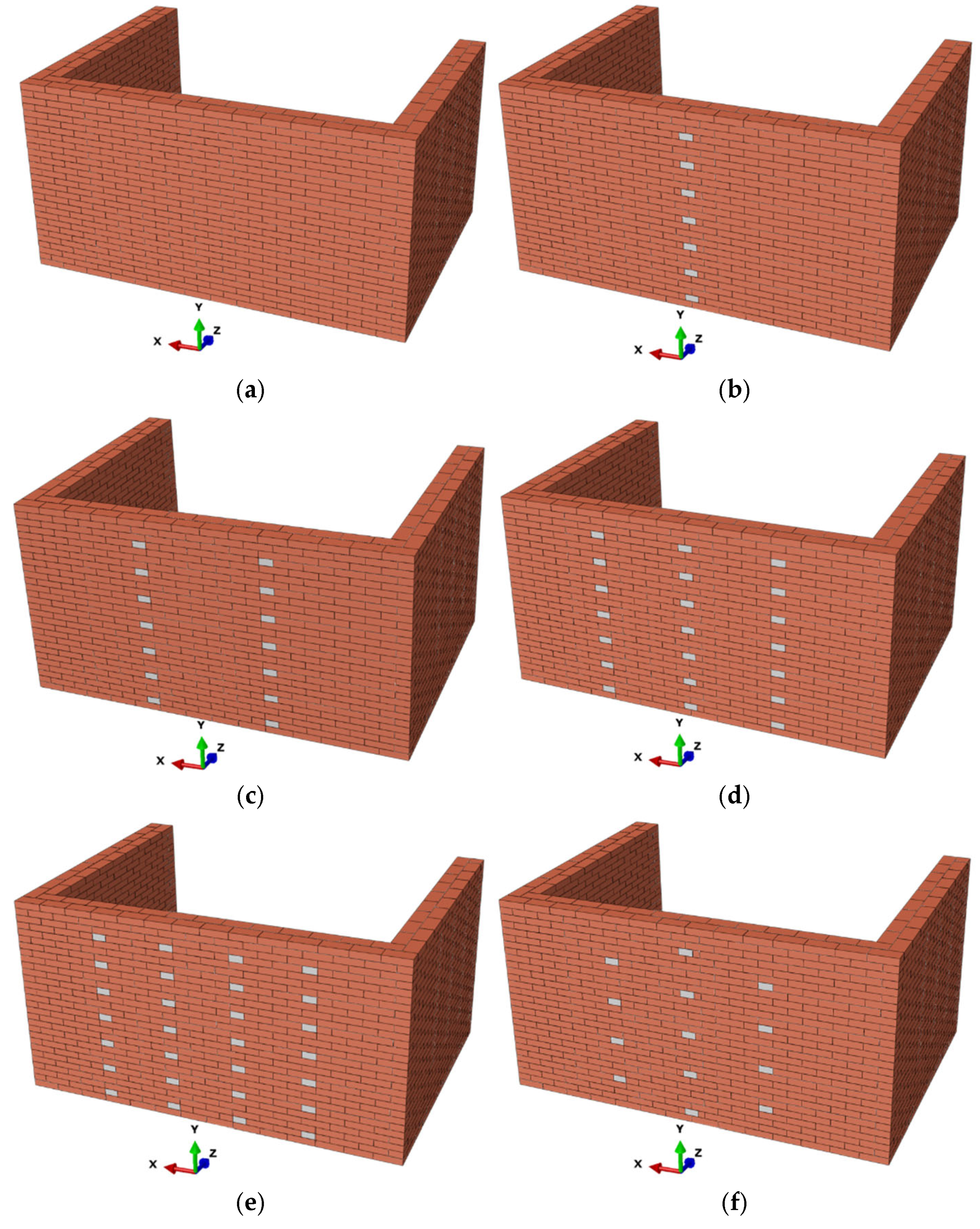

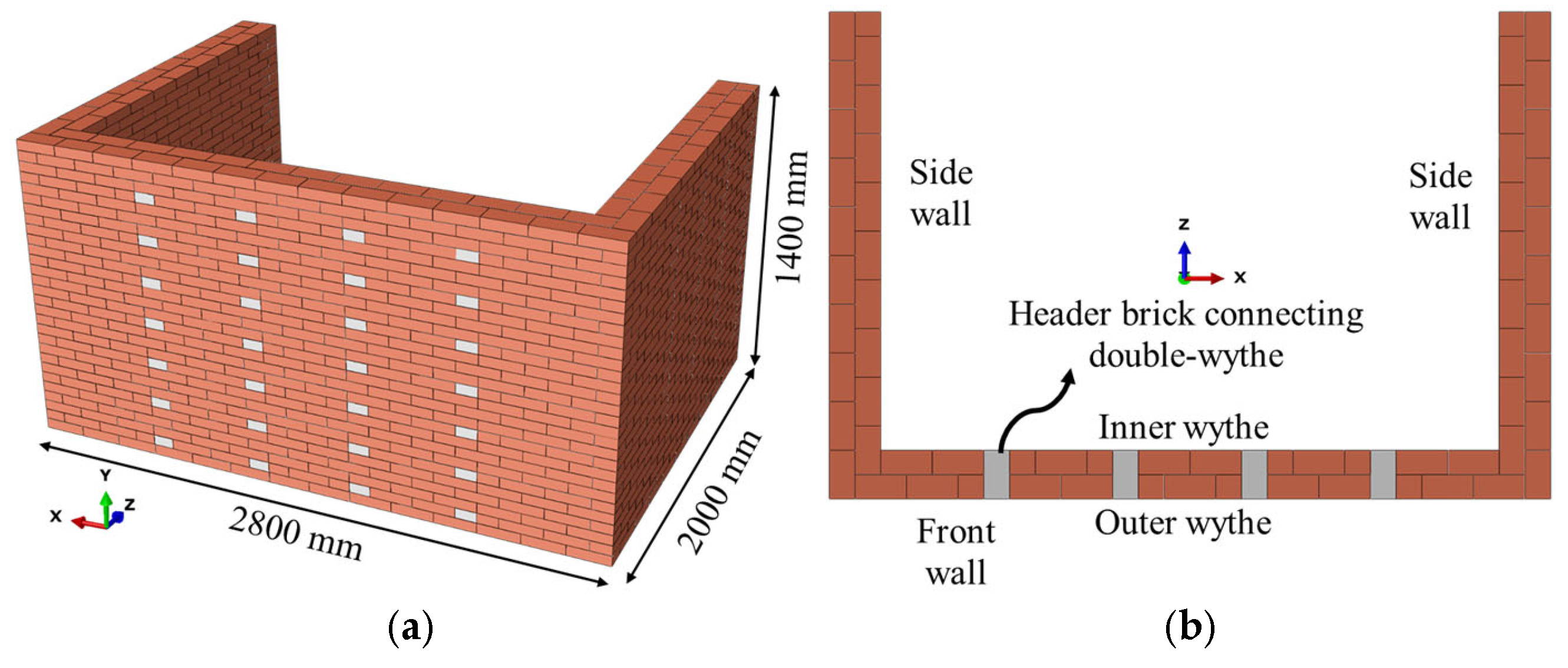


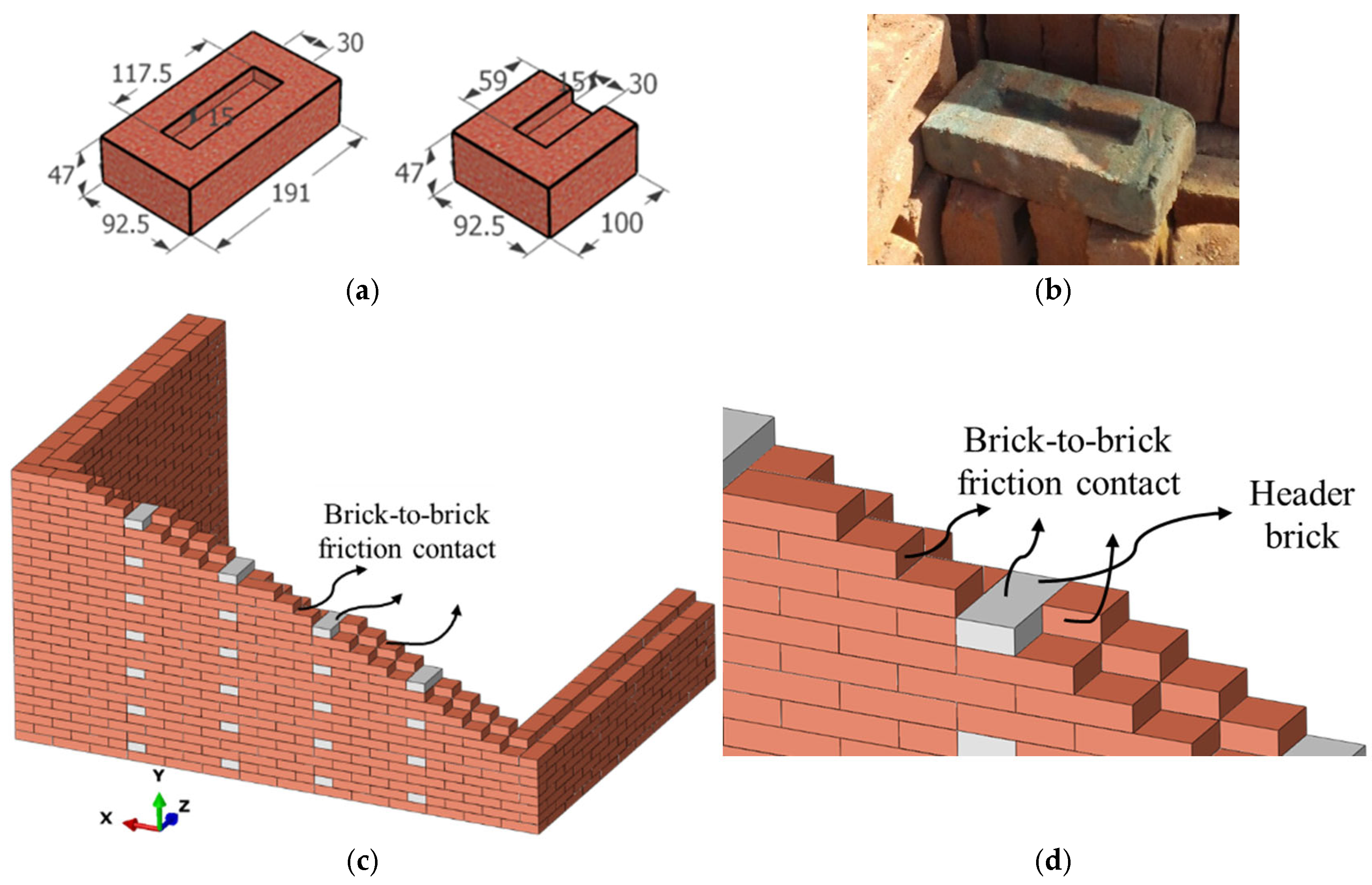

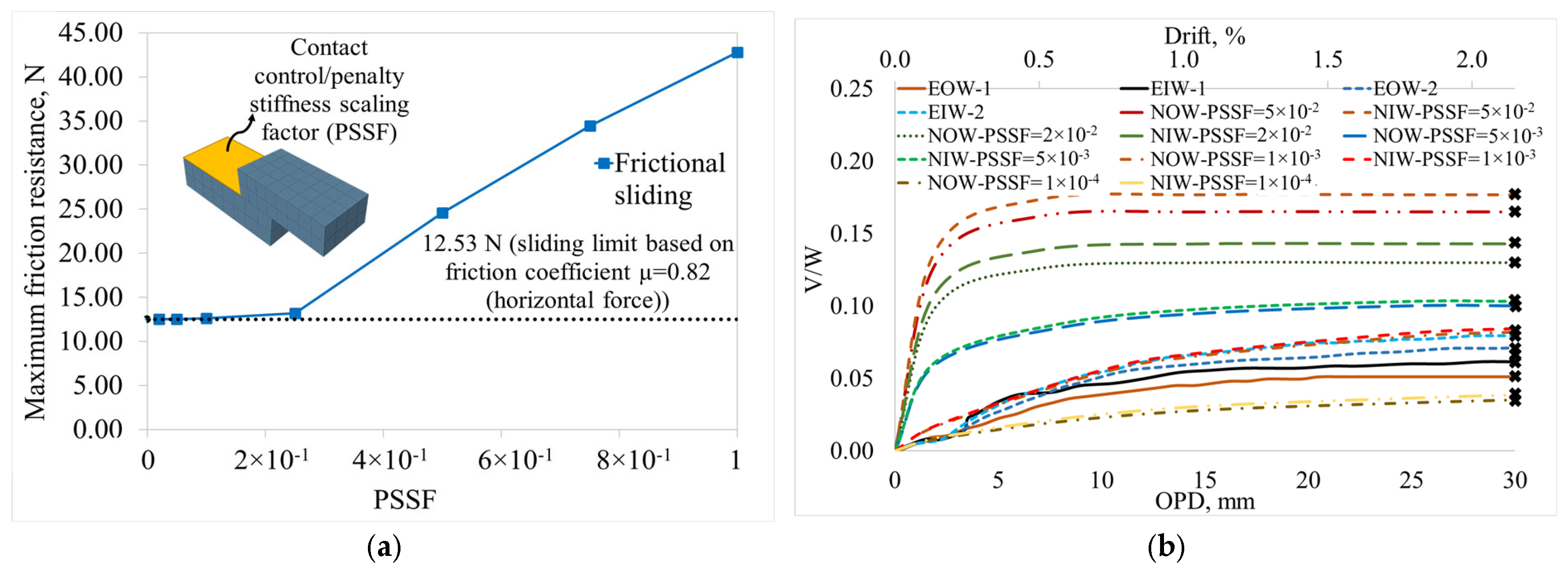
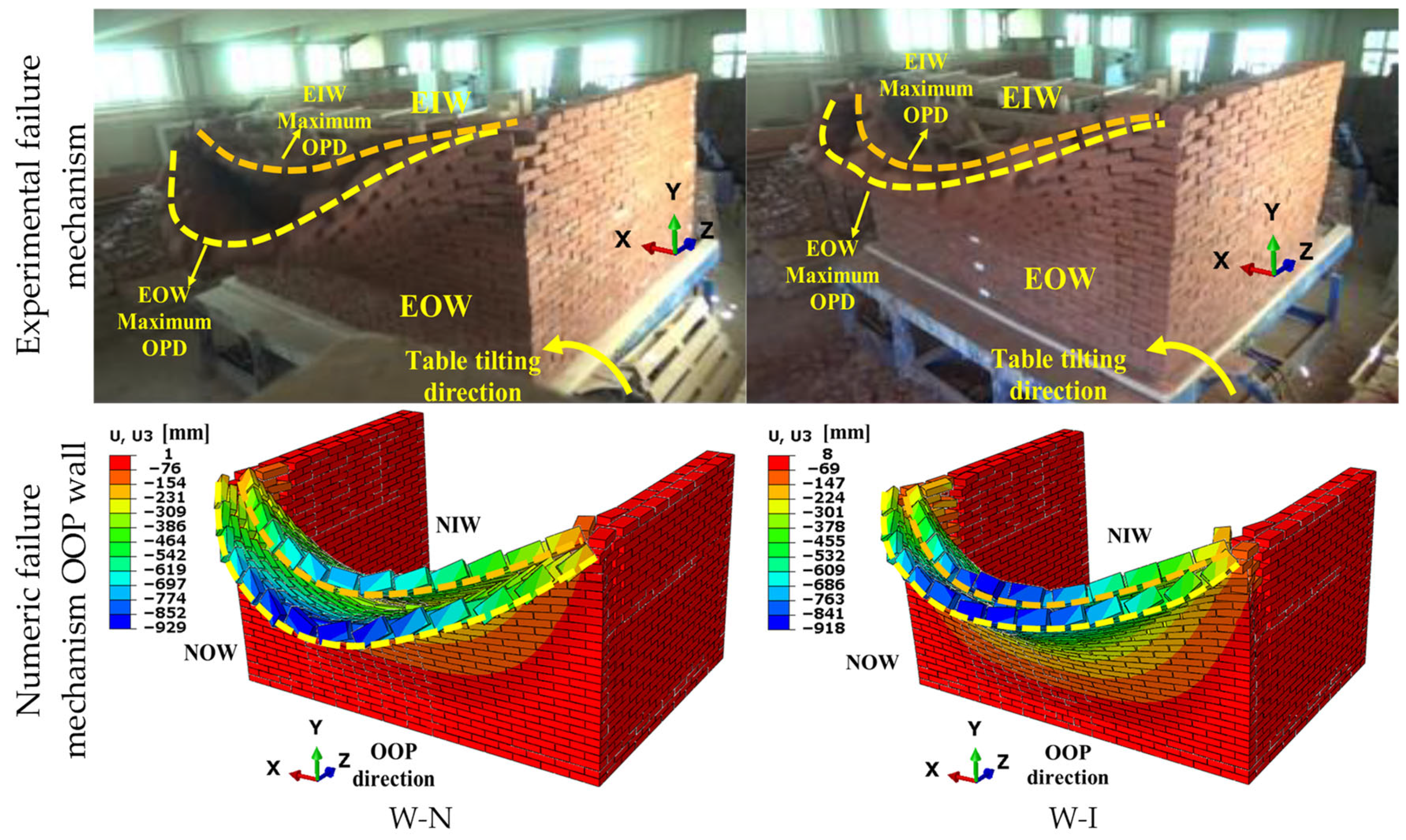



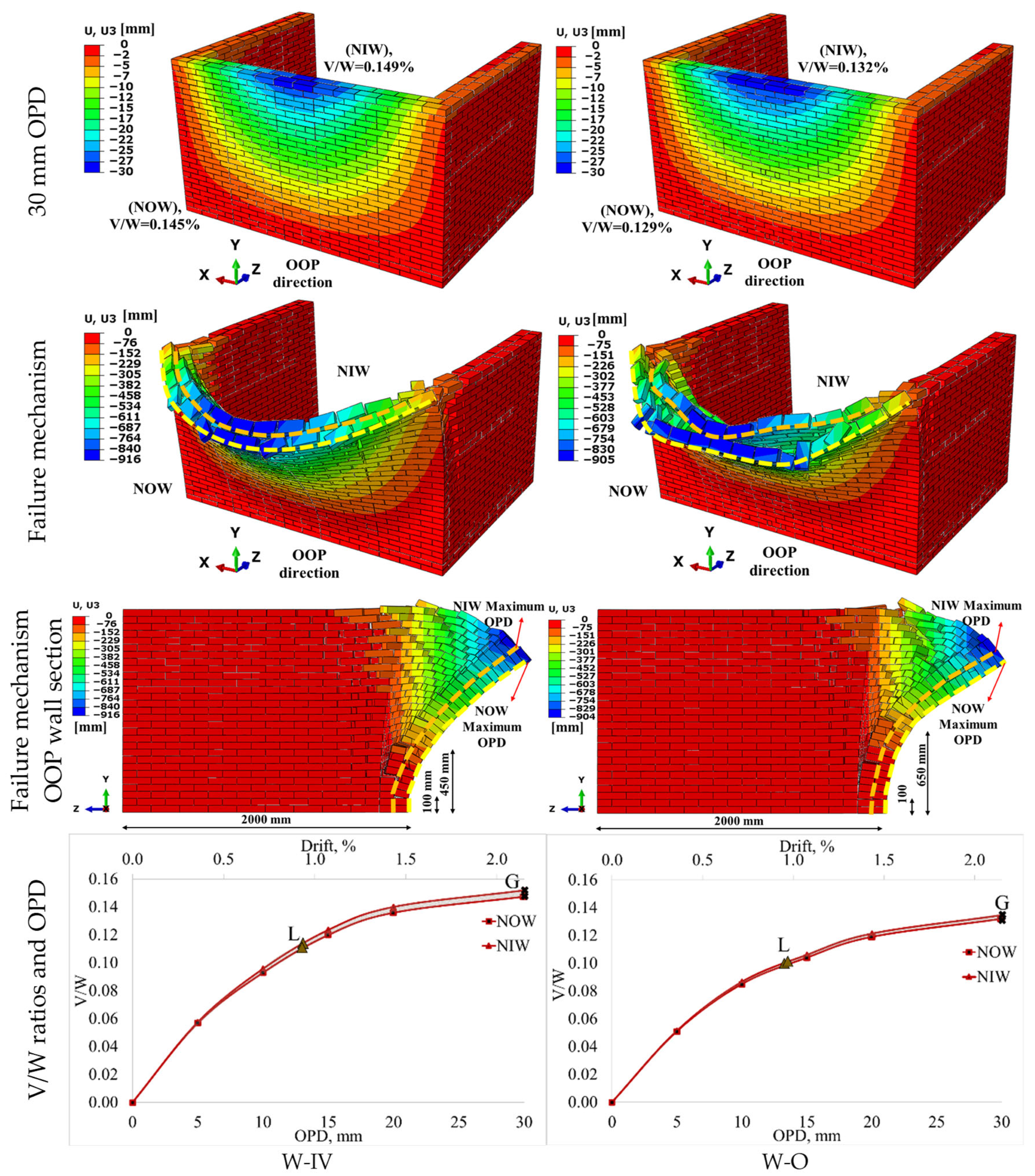
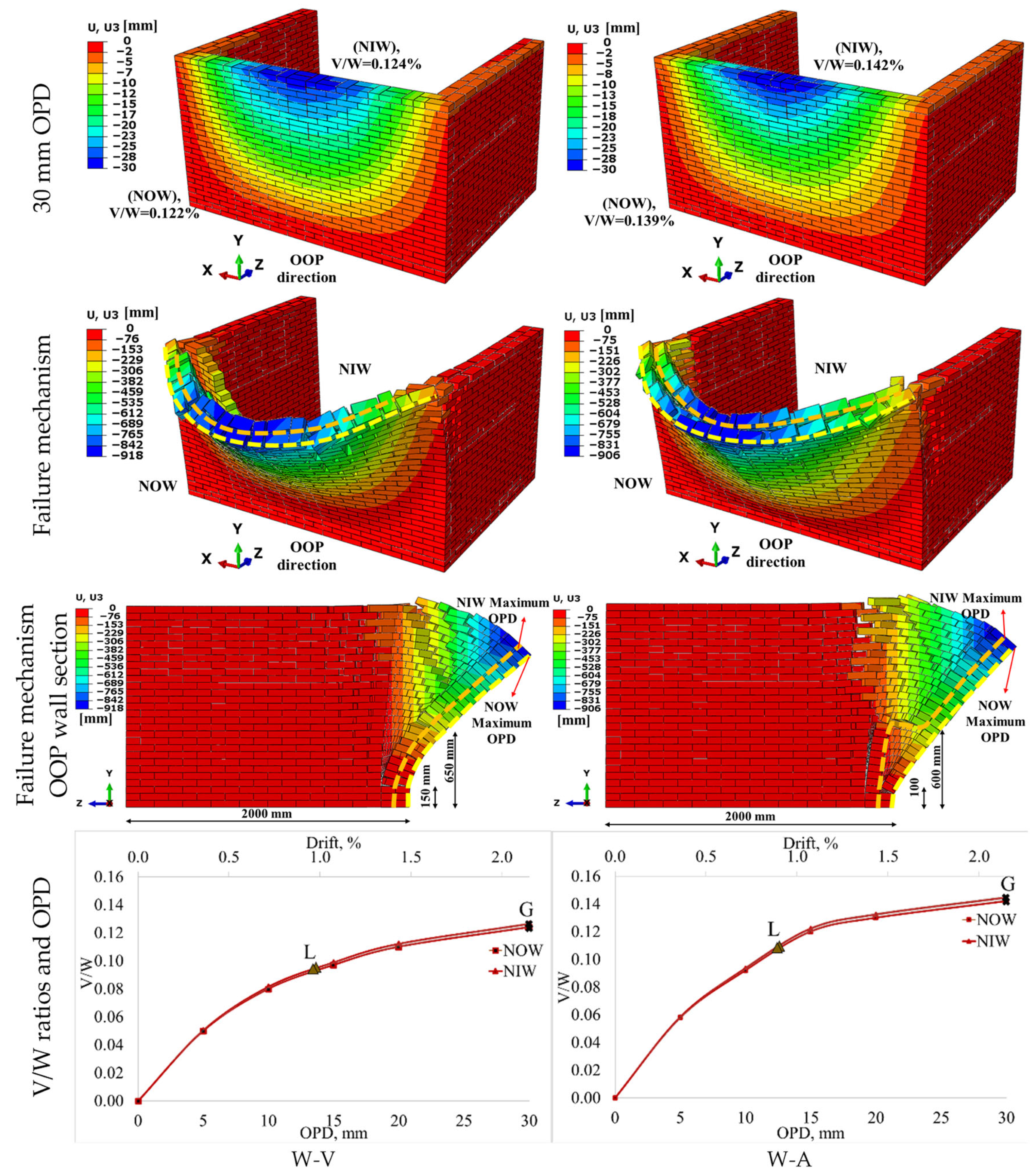

| Wall Model | Experimental Average (V/W) (%) | Numerical Average (V/W) (%) | L Point (75% V/W NOW) | Number of Header Bricks | Parametric Approach | |||||||
|---|---|---|---|---|---|---|---|---|---|---|---|---|
| EOW (±% Deviation) | EIW (±% Deviation) | NOW | NIW | Wall/W-N (Outer Wythe) | ||||||||
| W-N | 0.063 | ±19 | 0.072 | ±12 | 0.080 | 0.083 | 1.00 | 0.060 | 0 | 0.080 | 0.000 | 0.00 |
| W-I | 0.103 | ±0 | 0.104 | ±0 | 0.103 | 0.106 | 1.29 | 0.077 | 7 | 0.110 | 0.007 | 6.62 |
| W-II | - | 0.120 | 0.128 | 1.50 | 0.090 | 14 | 0.123 | 0.003 | 2.53 | |||
| W-III | 0.134 | 0.138 | 1.68 | 0.101 | 21 | 0.131 | 0.003 | 2.58 | ||||
| W-IV | 0.145 | 0.149 | 1.81 | 0.108 | 28 | 0.137 | 0.008 | 5.25 | ||||
| W-O | 0.129 | 0.132 | 1.61 | 0.097 | 13 | 0.121 | 0.008 | 6.36 | ||||
| W-V | 0.122 | 0.124 | 1.53 | 0.091 | 21 | 0.131 | 0.009 | 7.63 | ||||
| W-A | 0.139 | 0.142 | 1.74 | 0.104 | 21 | 0.131 | 0.008 | 6.01 | ||||
Disclaimer/Publisher’s Note: The statements, opinions and data contained in all publications are solely those of the individual author(s) and contributor(s) and not of MDPI and/or the editor(s). MDPI and/or the editor(s) disclaim responsibility for any injury to people or property resulting from any ideas, methods, instructions or products referred to in the content. |
© 2025 by the author. Licensee MDPI, Basel, Switzerland. This article is an open access article distributed under the terms and conditions of the Creative Commons Attribution (CC BY) license (https://creativecommons.org/licenses/by/4.0/).
Share and Cite
Kıpçak, F. Numerical Study of the Out-of-Plane Response of Dry-Stack Double-Wythe Brick Walls with Header Bricks. Buildings 2025, 15, 4342. https://doi.org/10.3390/buildings15234342
Kıpçak F. Numerical Study of the Out-of-Plane Response of Dry-Stack Double-Wythe Brick Walls with Header Bricks. Buildings. 2025; 15(23):4342. https://doi.org/10.3390/buildings15234342
Chicago/Turabian StyleKıpçak, Fırat. 2025. "Numerical Study of the Out-of-Plane Response of Dry-Stack Double-Wythe Brick Walls with Header Bricks" Buildings 15, no. 23: 4342. https://doi.org/10.3390/buildings15234342
APA StyleKıpçak, F. (2025). Numerical Study of the Out-of-Plane Response of Dry-Stack Double-Wythe Brick Walls with Header Bricks. Buildings, 15(23), 4342. https://doi.org/10.3390/buildings15234342






